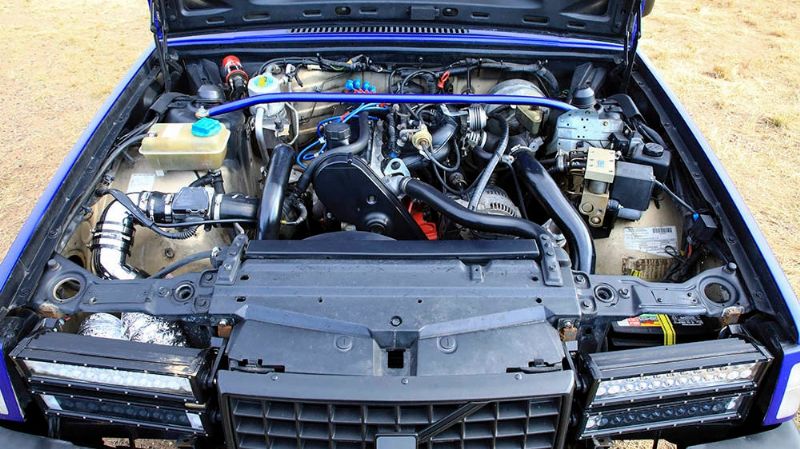The Surprising Performance Potential of Volvo Engine Swaps

Many fans of Swedish metal are eager to turn others onto the potential for Volvo performance. There are a surprising array of engine options and platforms that can make for the perfect oddball project. We've gathered some ideas to inspire you to consider a Volvo project car. Uncommon Performance: 1974-1993 Volvo 240 The humble Volvo 244 (sedan), 242 (coupe) and 245 (wagon) enjoyed nearly three decades of faithful service as the go-to car of choice for college professors, safety-conscious families, and free thinkers looking to escape Detroits grasp in an era when European imports were still a mixed bag when it came to quality and reliability. Collectively known as the Volvo 240, the line-ups stodgy, squared-off styling concealed an overbuilt design that still ensures a steady supply of driver-quality 200-Series cars decades after the last one left the assembly line. The rear-wheel drive 240 also happen to have evolved into one of the least-likely performance platforms out there, with a legion of dedicated owners providing a global support group for anyone who wants to try to squeeze at least a little speed and better handling out of these modestly-appointed automobiles. Volvo fans arent just found in their natural epicenter of Sweden, either; the United States is the next-most common country to spot a hopped-up 240 sitting at the autocross or quarter-mile starting line. There are many paths to take on the journey from slow poke to FTD behind the wheel of a Volvo 240. We dug down into the three most common starting points when adding some giddy-up to the Volvos go. From The Factory Typically, the Volvo 240 isnt much in a straight line right out of the box. The vast majority of 200-series Volvos youll find lurking on Craigslist are fitted with one of a handful of venerable but meek naturally-aspirated four-cylinder engines. These fuel injected, low-compression mills hover between 100 and 130 horsepower depending on the model and year. Still, there were a number of factory models available that were quicker than average, and which have become respectable starting points for would-be tuners. Volvo Redblock If you want to keep things in the family, there are a few Volvo-sourced swaps that are for the most part plug-and-play. Volvo was the first automaker to bring a turbocharged wagon to the American market (the famed redblock B21FT engine, with the mightier B21ET offered in Europe), and that experiment continued well past the 200-Series being put out to pasture, which means that its relatively easy to sources a turbocharged four-cylinder motor from either a 700-Series or 900-Series car and make it work in your 240. Forget chasing naturally-aspirated power, as your money will go a lot farther in the world of forced induction. Which engine should you target? The B230FT 2.3-liter redblock is one of the most popular swaps, with L block engines produced post-1993 offering thicker cylinder walls and an oil cooling system for the pistons. Truth be told, however, even K block or early B23 motors outfitted with the intercooler boost system are good for over 160 horses and decent torque in stock trim (although somewhat fragile connecting rods vulnerable to crankshaft flex are something to watch out for, fixed in later models thanks to a 50 percent thicker design and the relocation of the axial bearing). From The Aftermarket Turn up the boost via a larger turbo, add supporting fuel mods, and remap the ECU and you are looking at an easy 250 horsepower with solid reliability from a B230FT, but the first stop on the Volvo aftermarket typically isnt in the engine department. Rather, its to address to platforms various handling deficiencies. We spoke to Jared Lohnes at iPd , one of the longest-running (since 1963) Volvo performance operations in the United States, and he told us that the first modification he recommends is a set of larger swaybars front and rear, which wont compromise the ride, but will definitely wake-up handling. The stock 240 setup was intended to prioritize comfort over cornering, and Jared also considers a set of lowering springs (usually up to a 35mm drop), stiffer shock absorbers, and poly bushings all around as a great starting point. As with any car, larger wheels and stickier tires will tie it all together and offer some of the best bang for your buck when it comes to improving the cars reflexes. Once youve got the handling locked down, the next step for most Volvo tuners is to improve engine breathing via a larger, less restrictive exhaust, and a ported and polished head. A more aggressive camshaft is also a popular seller for iPd, and Lohnes explained that its a simple afternoon job whether youre running an NA or turbocharged Volvo engine. Most of the time the stock rear differential is going to be able to hold whatever Volvo-sourced power you throw at it (with the 700-Series G80 locker a popular choice for extra traction), so its not something youll need to upgrade right away. If your clutch has seen better days, thats not a bad place to allocate some of your budget. You might be tempted by chassis bracing and strut tower bars, but keep in mind that the stiffer you make the car, the less comfortable it will be on regular roads. Know your goals before ordering parts for your project and dont go overboard and risk ending up with a car you wont enjoy driving. From Left Field Rear-wheel drive, solid construction, plentiful parts availability: all three of these factors add up to a community of third-party engine swaps with a history dating back to the 1980s when Converse Engineering began selling the first Volvo 240s outfitted with 5.0-liter Ford V-8 engines. While the 302 continues to be a common, and relatively affordable swap for the Volvo crowd, the 200-Series is not immune to the wave of LS appreciation that has swept over the entire customization community. Affordable starting points include 4.8-liter and larger 5.3-liter V-8s scored from GM SUVs, while pricier builds involving 5.7-liter LS1 engines have all been done and documented online, opening up a world where 300 to 400 horsepower is easily attainable. Surprisingly, the extra torque brought on by these swaps doesnt have much of a negative effect on driveline components as one would think. If you want to graduate from the world of one-wheel burnouts to a full-locking diff out back, however, then a stouter unit is recommended (the 8.8-inch, 31-spline pumpkin out of a Ford Explorer is a popular choice). Its also important to consider the extra weightroughly 200 lbs in the case of an LS enginewhen installing a V-8 swap, which means bigger front brakes are a sound investment. Remember that these are just a few of the things you can do to a Volvo 240 to get the juices flowing quicker than they did when your sedan, coupe, or wagon originally left the factory. The only limit to how wild you want to get with your car is typically your budget, but if you use your imagination you can usually get around any financial roadblocks with a little creative engineering. Volvos are fun! If youd like to delve deeper into the Volvo performance community, we recommend checking out Turbo Bricks , one of the best online communities dedicated to the art of Swede speed. In addition to iPd USA, you can also get in touch with Elevate , which recently acquired K-PAX. While focused on more modern Volvos, its not a bad place to call if youre swapping a newer drivetrain into your 240. For more of a classic perspective, along with access to race-tested engine expertise, Vintage Performance Development has been focused on the Volvo community for the past 15 years. The post The Surprising Performance Potential of Volvo Engine Swaps appeared first on MotorTrend .
http://www.motortrend.com/news/lets-talk-volvo-engines/





